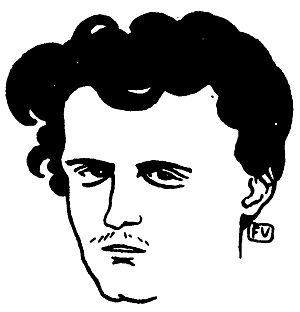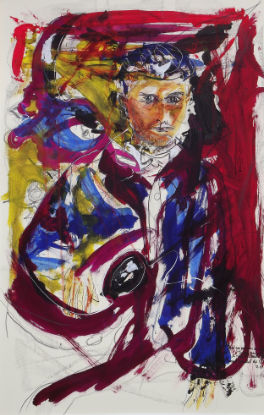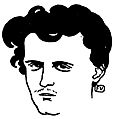Comte de Lautréamont facts for kids
Quick facts for kids
Comte de Lautréamont
|
|
|---|---|

Possibly a photo representing Lautréamont
|
|
| Born | Isidore Lucien Ducasse 4 April 1846 Montevideo, Uruguay |
| Died | 24 November 1870 (aged 24) Paris, France |
| Occupation | Poet |
Comte de Lautréamont was the pen name of Isidore Lucien Ducasse (born April 4, 1846 – died November 24, 1870). He was a French poet who was born in Uruguay.
His only two main works, Les Chants de Maldoror (which means The Songs of Maldoror) and Poésies (meaning Poems), had a big impact on modern art and literature. They especially influenced groups like the Surrealists and the Situationists. Ducasse died when he was only 24 years old.
Contents
About His Life
His Early Years
Isidore Ducasse was born in Montevideo, Uruguay. His father, François Ducasse, was a French official who worked for his country in Uruguay. Isidore's mother was Jacquette-Célestine Davezac.
We don't know much about Isidore's childhood. He was baptized in November 1847. His mother passed away soon after, possibly because of a widespread illness. In 1851, when he was five, he saw the end of a long war called the Siege of Montevideo. He grew up speaking three languages: French, Spanish, and English.
In October 1859, when he was thirteen, his father sent him to high school in France. He studied at the Imperial Lycée in Tarbes. Later, in 1863, he went to another school in Pau. He was good at math and drawing. He also had a very strong and unique way of thinking and writing.
Isidore enjoyed reading books by famous writers like Edgar Allan Poe, Percy Bysshe Shelley, and Lord Byron. He was also interested in French writers like Racine and Corneille. A school friend said that Isidore used many strong adjectives and described terrible things in his essays. After finishing school, he lived in Tarbes and decided he wanted to become a writer.
His Time in Paris
After a short visit with his father in Montevideo, Ducasse moved to Paris in late 1867. He started studying to get into a famous engineering school, but he stopped after a year. His father sent him money regularly, which allowed Ducasse to focus completely on his writing.
He lived in a part of Paris known for its thinkers and artists. He worked hard on the first part of his book, Les Chants de Maldoror. He might have started this work even before he went to Montevideo or during his journey by sea.
Ducasse often visited libraries nearby. He read romantic stories, science books, and encyclopedias. A publisher named Léon Genonceaux described him as a "large, dark, young man" who was "neat and industrious." Genonceaux also said Ducasse wrote "only at night, sitting at his piano, speaking loudly while playing the keys." However, this story might not be true.
In late 1868, Ducasse published the first part of Les Chants de Maldoror. He paid for it himself and didn't put his name on it.
On November 10, 1868, Ducasse sent a letter to the famous writer Victor Hugo. He included two copies of his first canto (a section of a long poem) and asked for help getting it published more widely. A new version of the first canto came out in January 1869. This time, Ducasse used his pen name "Comte de Lautréamont" for the first time.
His chosen name might have come from a popular book character named Latréaumont, who was a proud and rebellious antihero. This character was similar to Maldoror, the main character in Ducasse's book. The name could also mean "the other one from Montevideo" or "the other Amon." Some even think it was a joke about his father, who gave him a lot of money.
With his father's money, Ducasse arranged for six cantos of his book to be published in late 1869. The publisher, Albert Lacroix, printed the book. But then he refused to sell it in bookstores. He was worried he might get into trouble because the book's content was very strong and unusual. Ducasse thought this was because "life in it is painted in too harsh colors."
Ducasse asked Auguste Poulet-Malassis, a publisher who had worked with Baudelaire, to send copies of his book to critics. He hoped they would understand his work.
Poulet-Malassis announced the book's upcoming release in his magazine. But not many people paid attention to the book. Only one magazine mentioned it in May 1870, saying it would probably be seen as a "bibliographic curiosity."
His Death
During the spring of 1869, Ducasse moved homes often in Paris. While waiting for his book to be sold, Ducasse started writing a new text. This new work was meant to be about "good," as a contrast to his earlier work about "evil." However, he never finished it.
In April and June 1870, Ducasse published the first two parts of what was meant to be the introduction to his "chants of the good." These were two small booklets called Poésies I and II. This time, he used his real name, Isidore Ducasse, instead of his pen name.
In these booklets, he used ideas and phrases from other famous writers like Blaise Pascal and La Rochefoucauld. He even improved some parts of his own Les Chants de Maldoror. The booklets were sold without a set price; customers could pay what they wanted.
On July 19, 1870, France declared war on Prussia. Paris was soon surrounded by enemy forces, which Ducasse had experienced before as a child in Montevideo. Life became very difficult during the siege. The owner of his hotel said Ducasse got sick with a "bad fever."
Lautréamont died at the age of 24, on November 24, 1870. His death certificate gave "no further information." Because many people were afraid of illnesses during the siege, Ducasse was buried quickly the next day in a temporary grave. Later, in January 1871, his body was moved to another grave.
In his Poésies, Lautréamont wrote: "I will leave no memoirs." Because of this, much of the life of the person who created Les Chants de Maldoror remains a mystery.
Les Chants de Maldoror
Les Chants de Maldoror is a book about a character named Maldoror. He is a very evil figure who has turned away from God and humanity. The book mixes a violent story with strong and often dream-like images.
A critic named Alex De Jonge wrote that Lautréamont makes readers think differently about the world. He makes them see that what they think is real might actually be like a scary dream.
There are many studies and interpretations of Lautréamont's writing in French, but not as many in English.
Lautréamont's writing has many strange scenes, vivid pictures, and sudden changes in mood and style. It also has a lot of "black humor" (dark jokes). De Jonge says that Maldoror reads like a "sustained sick joke."
Poésies
Poésies (Poems or Poetry) is Ducasse's other, less famous, surviving work. It is split into two parts. Unlike Maldoror, Poésies was published under Ducasse's real name.
Both parts are made up of short, wise sayings or aphorisms in prose. These sayings share his thoughts on literature and poetry. They often talk about famous writers from history and compare their works. Some of the writers he mentioned include ancient Greek playwrights, Edgar Allan Poe, and many French authors of his time, like Charles Baudelaire and Victor Hugo.
So, Poésies is not a collection of poems, even though its title suggests it. Instead, it is a work of literary criticism, where he shares his ideas about writing. Poésies is also different from the dark themes of Maldoror. It uses much more positive and hopeful language.
However, there are some things that are similar to Maldoror. Both works often describe animals using comparisons. And even though God is praised in Poésies, other parts suggest that humans are more important than God. For example, one line says: "Elohim (God) is made in man's image."
Influence on Surrealism
In 1917, a French writer named Philippe Soupault found a copy of Les Chants de Maldoror in a small bookstore in Paris. He found it in the math section!
Because of this discovery, Lautréamont became known to the Surrealists. Soon, they called him their prophet. The Surrealists were a group of artists and writers who explored dreams and the unconscious mind. Lautréamont was seen as one of the "cursed poets" and was placed alongside famous writers like Charles Baudelaire and Arthur Rimbaud. He was recognized as someone who directly inspired Surrealism.
In the first Manifesto of Surrealism (1924), André Breton, a leader of the Surrealists, wrote: "With Les Chants de Maldoror Surrealism was born." Another writer, André Gide, thought Lautréamont was even more important than Rimbaud. He called him the "gate-master of tomorrow's literature."
Louis Aragon and Breton found the only copies of Poésies in the National Library of France. They published the text in their magazine in 1919. In 1925, a special issue of a Surrealist magazine was dedicated to Lautréamont. A 1927 publication by Soupault and Breton made sure Lautréamont had a lasting place in French literature and became a hero for the Surrealist movement. In 1930, Aragon called Lautréamont the "true initiator of the modern marvelous," which was a key idea in Surrealism.
An artwork by American artist Man Ray from 1920 is called L'énigme d'Isidore Ducasse (The Enigma of Isidore Ducasse). This title refers to a famous line from Maldoror: Lautréamont described a young boy as "beautiful as the chance meeting on a dissecting-table of a sewing-machine and an umbrella." Breton often used this line as an example of Surrealist ideas. It shows how strange and unexpected things can be put together to create something new.
Many artists were inspired by Maldoror, including Salvador Dalí, Man Ray, and René Magritte. The artist Amedeo Modigliani always carried a copy of the book with him and would often quote from it.

Since no real photograph of Lautréamont exists, artists like Félix Vallotton and Dalí created "imagined" portraits of him.
His Impact on Others
Kadour Naimi created a play in 1984 and a film in 1997 based on Les Chants de Maldoror.
A part of Maldoror is read aloud near the end of Jean-Luc Godard's 1967 film Week End.
Situationist founder, filmmaker, and author Guy Debord used a section from Poésies II in his book The Society of the Spectacle. This section talks about how using ideas from other authors can be important for progress. It explains that taking an author's phrase and changing it slightly can replace a wrong idea with a right one. Another Situationist, Raoul Vaneigem, also thought Lautréamont's ideas were very important.
Writers Jean Paulhan and Henri Michaux both said Lautréamont influenced their work.
Kenneth Anger, a filmmaker, said he tried to make a movie based on Maldoror but couldn't get enough money to finish it.
John Ashbery, an American poet influenced by surrealism, named his 1992 book Hotel Lautréamont. The English edition notes that Lautréamont is "one of the forgotten presences alive" in the book.
The Brazilian author Joca Reiners Terron includes a character named Isidoro Ducasse in his novel Não Há Nada Lá. This character becomes very interested in a book of poems while traveling by train. Ducasse and his Chants de Maldoror are also mentioned in Jô Soares' 1995 novel O Xangô de Baker Street. The musician Rogério Skylab has a song named after the Chants of Maldoror.
Isidore Ducasse is the name of a fashion designer character in William Klein's 1966 movie Who Are You, Polly Maggoo?.
Lautréamont appears as an unnamed "South American" character in Julio Cortázar's short story "The Other Heaven." This story also uses quotes from Maldoror.
French philosophers Gilles Deleuze and Félix Guattari mentioned Lautréamont twice in their two-volume work, Capitalism and Schizophrenia.
Images for kids
-
An imagined portrait of Lautréamont by Félix Vallotton in The Book of masks from Remy de Gourmont (1898).
See also
 In Spanish: Conde de Lautréamont para niños
In Spanish: Conde de Lautréamont para niños







